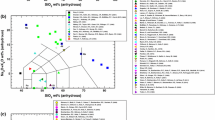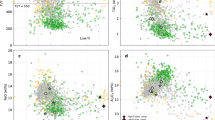Abstract
Crystallization experiments have been conducted on compositions along tholeiitic liquid lines of descent to define the compositional space for the development of silicate liquid immiscibility. Starting materials have 46–56 wt% SiO2, 11.7–17.7 wt% FeOtot, and Mg-number between 0.29 and 0.36. These melts fall on the basaltic trends relevant for Mull, Iceland, Snake River Plain lavas and for the Sept Iles layered intrusion, where large-scale liquid immiscibility has been recognized. At one atmosphere under anhydrous conditions, immiscibility develops below 1,000–1,020°C in all of these compositionally diverse lavas. Extreme iron enrichment is not necessary; immiscibility also develops during iron depletion and silica enrichment. Variations in melt composition control the development of silicate liquid immiscibility along the tholeiitic trend. Elevation of Na2O + K2O + P2O5 + TiO2 promotes the development of two immiscible liquids. Increasing melt CaO and Al2O3 stabilizes a single-liquid field. New data and published phase equilibria show that anhydrous, low-pressure fractional crystallization is the most favorable condition for unmixing during differentiation. Pressure inhibits immiscibility because it expands the stability field of high-Ca clinopyroxene, which reduces the proportion of plagioclase in the crystallizing assemblage, thus enhancing early iron depletion. Magma mixing between primitive basalt and Fe–Ti–P-rich ferrobasalts can serve to elevate phosphorous and alkali contents and thereby promote unmixing. Water might decrease the temperature and size of the two-liquid field, potentially shifting the binodal (solvus) below the liquidus, leading the system to evolve as a single-melt phase.










Similar content being viewed by others
References
Armstrong JT (1995) Citzaf—a package of correction programs for the quantitative electron microbeam X-ray analysis of thick polished materials, thin-films, and particles. Microbeam Anal 4:177–200
Berndt J, Koepke J, Holtz F (2005) An experimental investigation of the influence of water and oxygen fugacity on differentiation of MORB at 200 MPa. J Petrol 46:135–167
Bogaerts M, Schmidt MW (2006) Experiments on silicate melt immiscibility in the system Fe2SiO4-KAlSi3O8-SiO2-CaO-MgO-TiO2-P2O5 and implications for natural magmas. Contrib Mineral Petrol 152:257–274
Botcharnikov RE, Almeev RR, Koepke J, Holtz F (2008) Phase relations and liquid lines of descent in hydrous ferrobasalt—implications for the Skaergaard intrusion and Columbia River flood basalts. J Petrol 49:1687–1727
Brooks CK, Nielsen TFD (1978) Early stages in the differentiation of the Skaergaard magma as revealed by a closely related suite of dike rocks. Lithos 11:1–14
Carmichael ISE (1964) The petrology of Thingmuli, a tertiary volcano in eastern Iceland. J Petrol 5:435–460
Charlier B, Namur O, Toplis MJ, Schiano P, Cluzel N, Higgins MD, Vander Auwera J (2011) Large-scale silicate liquid immiscibility during differentiation of tholeiitic basalt to granite and the origin of the Daly gap. Geology 39:907–910
Danyushevsky LV (2001) The effect of small amounts of H2O on crystallisation of mid-ocean ridge and backarc basin magmas. J Volcanol Geotherm Res 110:265–280
Dixon S, Rutherford MJ (1979) Plagiogranites as late-stage immiscible liquids in ophiolite and mid-ocean ridge suites: an experimental study. Earth Planet Sci Lett 45:45–60
Freestone IC, Powell R (1983) The low temperature field of liquid immiscibility in the system K2O-Al2O3-FeO-SiO2 with special reference to the join fayalite-leucite-silica. Contrib Mineral Petrol 82:291–299
Ghiorso MS (1997) Thermodynamic models of igneous processes. Annu Rev Earth Planet Sci 25:221–241
Grove TL (1981) Use of FePt alloys to eliminate the iron loss problem in 1 atmosphere gas mixing experiments: Theoretical and practical considerations. Contrib Mineral Petrol 78:298–304
Grove TL, Baker MB (1984) Phase equilibrium controls on the tholeiitic versus calc-alkaline differentiation trends. J Geophys Res 89:3253–3274
Grove TL, Bryan WB (1983) Fractionation of pyroxene-phyric MORB at low pressure: an experimental study. Contrib Mineral Petrol 84:293–309
Grove TL, Kinzler RJ, Bryan WB (1992) Fractionation of midocean ridge basalt (MORB). In: Morgan JP, Blackman DK, Sinton JM (eds) Mantle flow and melt generation at mid-ocean ridges, vol 71. Amer Geophysical Union, Washington, pp 281–310
Harrison TM, Watson EB (1984) The behavior of apatite during crustal anatexis: equilibrium and kinetic considerations. Geochim Cosmochim Acta 48:1467–1477
Hess P (1977) Structure of silicate melts. Can Mineral 15:162–178
Holness MB, Stripp G, Humphreys MCS, Veksler IV, Nielsen TFD, Tegner C (2011) Silicate liquid immiscibility within the crystal mush: late-stage magmatic microstructures in the Skaergaard intrusion, East Greenland. J Petrol 52:175–222
Hudon P, Jung I-H, Baker DR (2004) Effect of pressure on liquid–liquid miscibility gaps: a case study of the systems CaO-SiO2, MgO-SiO2, and CaMgSi2O6-SiO2. J Geophys Res 109:B03207
Humphreys MCS (2011) Silicate liquid immiscibility within the crystal mush: evidence from Ti in plagioclase from the Skaergaard intrusion. J Petrol 52:147–174
Jakobsen JK, Veksler IV, Tegner C, Brooks CK (2005) Immiscible iron- and silica-rich melts in basalt petrogenesis documented in the Skaergaard intrusion. Geology 33:885–888
Jakobsen JK, Veksler IV, Tegner C, Brooks CK (2011) Crystallization of the Skaergaard intrusion from an emulsion of immiscible iron- and silica-rich liquids: evidence from melt inclusions in plagioclase. J Petrol 52:345–373
Juster TC, Grove TL, Perfit MR (1989) Experimental constraints on the generation of FeTi basalts, andesites, and rhyodacites at the Galapagos spreading center, 85 W and 95 W. J Geophys Res 94:9251–9274
Kerr AC, Kent RW, Thomson BA, Seedhouse JK, Donaldson CH (1999) Geochemical evolution of the Tertiary Mull volcano, western Scotland. J Petrol 40:873–908
Koster Van Groos AF, Wyllie PJ (1968) Liquid immiscibility in join NaAlSi3O8-Na2CO3-H2O and its bearing on genesis of carbonatites. Am J Sci 266:932–967
Lee W-J, Wyllie PJ (1994) Experimental data bearing on liquid immiscibility, crystal fractionation, and the origin of calciocarbonatites and natrocarbonatites. Int Geol Rev 36:797–819
Leeman WP, Vitaliano CJ, Prinz M (1976) Evolved lavas from the snake river plain: craters of the moon national monument, Idaho. Contrib Mineral Petrol 56:35–60
Longhi J (1990) Silicate liquid immiscibility in isothermal crystallization experiments. Proceedings of the lunar planet science conference 20th, pp 13–24
Martin B, Kushiro I (1991) Immiscibility synthesis as an indication of cooling rates of basalts. J Volcanol Geotherm Res 45(3–4):289–310
McBirney AR (1975) Differentiation of the Skaergaard Intrusion. Nature 253:691–694
McBirney AR (2008) Comments on: ‘Liquid immiscibility and the evolution of basaltic magma’ J Petrol 48, 2187–2210. J Petrol 49:2169–2170
Médard E, Grove T (2008) The effect of H2O on the olivine liquidus of basaltic melts: experiments and thermodynamic models. Contrib Mineral Petrol 155:417–432
Morse SA (2008) Compositional convection trumps silicate liquid immisciblity in layered intrusions: a Discussion of ‘Liquid immiscibility and the evolution of basaltic magma’ by Veksler et al., J Petrol 48, 2187–2210. J Petrol 49:2157–2168
Mysen BO (1983) The structure of silicate melts. Annu Rev Earth Planet Sci 11:75–97
Namur O, Charlier B, Toplis MJ, Higgins MD, Liégeois J-P, Vander Auwera J (2010) Crystallization sequence and magma chamber processes in the ferrobasaltic Sept Iles layered intrusion, Canada. J Petrol 51:1203–1236
Namur O, Charlier B, Toplis MJ, Higgins MD, Hounsell V, Liégeois J-P, Vander Auwera J (2011) Differentiation of tholeiitic basalt to A-type granite in the Sept Iles layered intrusion, Canada. J Petrol 52:487–539
Naslund HR (1983) The effect of oxygen fugacity on liquid immiscibility in iron-bearing silicate melts. Am J Sci 283:1034–1059
Philpotts AR (1979) Silicate liquid immiscibility in tholeiitic basalts. J Petrol 20:99–118
Philpotts AR (1982) Compositions of immiscible liquids in volcanic rocks. Contrib Mineral Petrol 80:201–218
Philpotts AR (2008) Comments on: liquid immiscibility and the evolution of basaltic magma. J Petrol 49:2171–2175
Philpotts AR, Doyle CD (1983) Effect of magma oxidation state on the extent of silicate liquid immiscibility in a tholeiitic basalt. Am J Sci 283:967–986
Putirka KD, Kuntz MA, Unruh DM, Vaid N (2009) Magma evolution and ascent at the craters of the moon and neighboring volcanic fields, Southern Idaho, USA: implications for the evolution of polygenetic and monogenetic volcanic fields. J Petrol 50:1639–1665
Roedder E (1978) Silicate liquid immiscibility in magmas and in the system K2O-FeO-Al2O3-SiO2: an example of serendipity. Geochim Cosmochim Acta 42:1597–1617
Ryerson FJ, Hess PC (1978) Implications of liquid–liquid distribution coefficients to mineral-liquid partitioning. Geochim Cosmochim Acta 42:921–932
Schmidt MW, Connolly JAD, Günther D, Bogaerts M (2006) Element partitioning: the role of melt structure and composition. Science 312:1646–1650
Sisson TW, Grove TL (1993) Experimental investigations of the role of H2O in calc-alkaline differentiation and subduction zone magmatism. Contrib Mineral Petrol 113:143–166
Thy P, Lesher CE, Nielsen TFD, Brooks CK (2006) Experimental constraints on the Skaergaard liquid line of descent. Lithos 92:154–180
Toplis MJ, Carroll MR (1995) An experimental study of the influence of oxygen fugacity on Fe-Ti oxide stability, phase relations, and mineral-melt equilibria in ferro-basaltic systems. J Petrol 36:1137–1170
Toplis MJ, Carroll MR (1996) Differentiation of ferro-basaltic magmas under conditions closed and open to oxygen: implications for the Skaergaard intrusion and other natural systems. J Petrol 37:837–858
Toplis MJ, Libourel G, Carroll MR (1994) The role of phosphorous in crystallization processes of basalt: an experimental study. Geochim Cosmochim Acta 58:797–810
Veksler IV (2009) Extreme iron enrichment and liquid immiscibility in mafic intrusions: experimental evidence revisited. Lithos 111:72–82
Veksler I, Dorfman A, Danyushevsky L, Jakobsen J, Dingwell D (2006) Immiscible silicate liquid partition coefficients: implications for crystal-melt element partitioning and basalt petrogenesis. Contrib Mineral Petrol 152:685–702
Veksler IV, Dorfman AM, Borisov AA, Wirth R, Dingwell DB (2007) Liquid immiscibility and the evolution of basaltic magma. J Petrol 48:2187–2210
Veksler IV, Dorfman AM, Borisov AA, Wirth R, Dingwell DB (2008) Liquid immiscibility and evolution of basaltic magma: Reply to S. A. Morse, A. R. McBirney and A. R. Philpotts. J Petrol 49:2177–2186
Veksler IV, Kahn J, Franz G, Dingwell DB (2010) Interfacial tension between immiscible liquids in the system K2O-FeO-Fe2O3-Al2O3-SiO2 and implications for the kinetics of silicate melt unmixing. Am Mineral 95:1679–1685
Villiger S, Ulmer P, Müntener O, Thompson AB (2004) The liquid line of descent of anhydrous, mantle-derived, tholeiitic liquids by fractional and equilibrium crystallization-an experimental study at 1.0 GPa. J Petrol 45:2369–2388
Villiger S, Ulmer P, Müntener O (2007) Equilibrium and fractional crystallization experiments at 0.7 GPa; the effect of pressure on phase relations and liquid compositions of tholeiitic magmas. J Petrol 48:159–184
Visser W, Koster van Groos AF (1979a) Phase relations in the system K2O-FeO-Al2O3-SiO2 at 1 atmosphere with special emphasis on low temperature liquid immiscibility. Am J Sci 279:70–91
Visser W, Koster van Groos AF (1979b) Effect of P2O5 and TiO2 on liquid–liquid equilibria in the system K2O-FeO-Al2O3-SiO2. Am J Sci 279:970–988
Visser W, Koster van Groos AF (1979c) Effect of pressure on liquid immiscibility in the system K2O-FeO-Al2O3-SiO2-P2O5. Am J Sci 279:1160–1175
Watson EB (1976) Two-liquid partition coefficients: experimental data and geochemical implications. Contrib Mineral Petrol 56:119–134
Wood MI, Hess PC (1980) The structural role of Al2O3 and TiO2 in immiscible silicate liquids in the system SiO2-MgO-CaO-FeO-TiO2-Al2O3. Contrib Mineral Petrol 72:319–328
Acknowledgments
BC acknowledges support by a Marie Curie International Outgoing Fellowship within the 7th European Community Framework Programme. TLG acknowledges support from NSF Grant EAR 1118598. Comments by A. Andrews, J.C. Duchesne, B. Mandler, and O. Namur have been greatly appreciated. Reviews by R. Botcharnikov and I. Veksler have improved the manuscript.
Author information
Authors and Affiliations
Corresponding author
Additional information
Communicated by J. Hoefs.
Rights and permissions
About this article
Cite this article
Charlier, B., Grove, T.L. Experiments on liquid immiscibility along tholeiitic liquid lines of descent. Contrib Mineral Petrol 164, 27–44 (2012). https://doi.org/10.1007/s00410-012-0723-y
Received:
Accepted:
Published:
Issue Date:
DOI: https://doi.org/10.1007/s00410-012-0723-y




